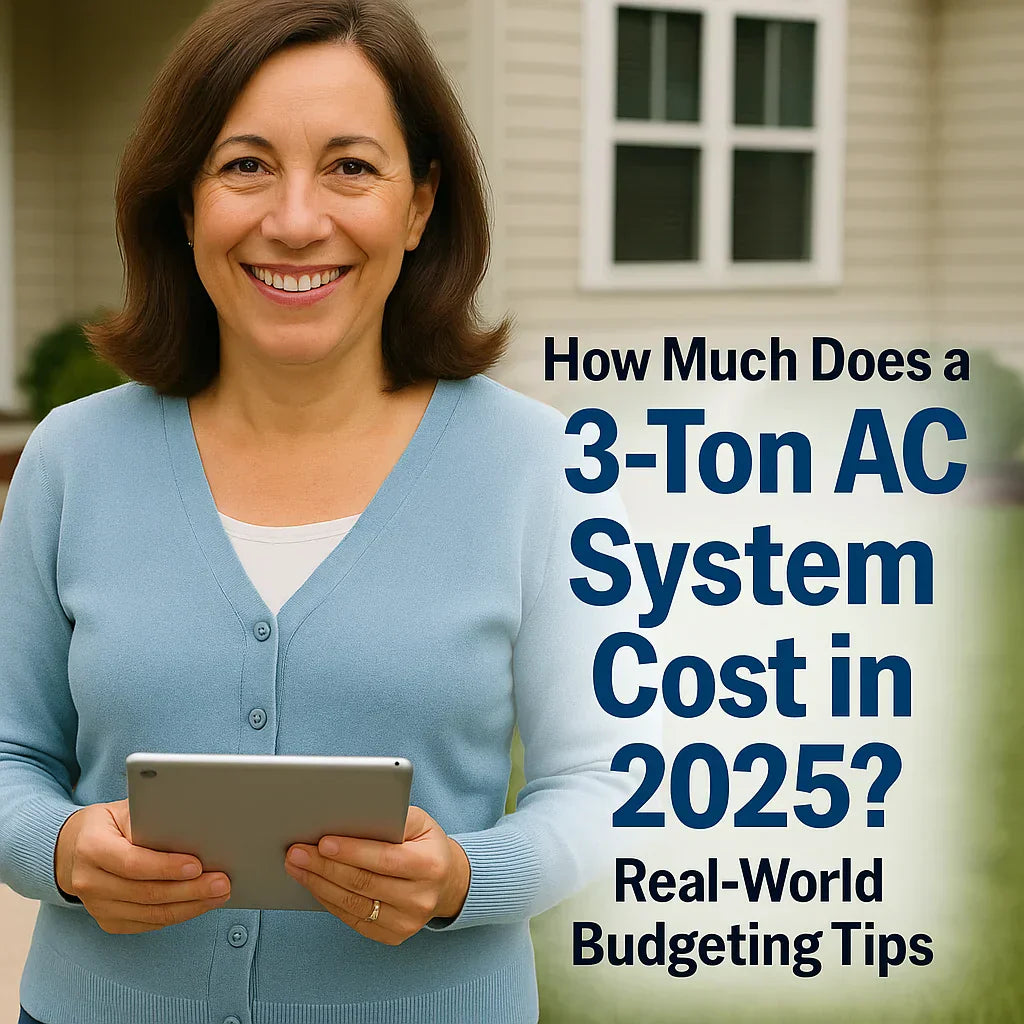🏡 Why Cost Planning Matters Before You Buy
Hi there — Samantha here.
If you’re reading this, you’re probably like I was a few summers ago: staring at my old, noisy AC unit, wondering how much longer it could last before giving me the dreaded “warm air in July” surprise.
I quickly realized that buying a new 3-ton AC system isn’t just about the price tag on the box — it’s about total ownership cost. That means factoring in installation, accessories, efficiency upgrades, maintenance, and even how your local climate impacts both cost and comfort.
Today, we’ll break it all down into real-world budgeting tips so you’ll know exactly what to expect in 2025.
📊 What Does “3-Ton” Mean Again?
Before we dive into the numbers, let’s refresh our understanding:
-
1 ton of AC capacity = 12,000 BTUs/hour
-
3 tons = ~36,000 BTUs/hour — generally suitable for homes between 1,500 and 2,100 sq ft, depending on insulation, ceiling height, and climate.
The size affects price, but features and efficiency ratings can swing the budget even more.
💵 Typical 2025 Price Ranges for a 3-Ton AC System
The cost in 2025 depends on the efficiency (SEER2) rating, brand, and whether it’s a replacement or a brand-new install. Here’s a rough national average:
| Tier | SEER2 Rating | Equipment Price | Installed Price |
|---|---|---|---|
| Budget | 14.3–15.2 SEER2 | $2,800–$3,800 | $5,200–$6,800 |
| Midrange | 16–18 SEER2 | $3,900–$5,000 | $6,900–$8,500 |
| Premium | 19+ SEER2 (variable speed) | $5,100–$6,800 | $8,800–$11,500 |
🛠 Breaking Down the Cost Components
When I bought my 3-ton system, I was surprised to learn that the unit itself was only about half of the total cost. Here’s why:
1. Equipment
-
Outdoor condenser
-
Indoor evaporator coil
-
Air handler or furnace (if replacing)
Typical range: $2,800–$6,800 depending on SEER2, brand, and refrigerant (R-32 or R-410A).
2. Installation Labor
HVAC pros handle:
-
Removing old unit
-
Setting pad & mounting condenser
-
Installing evaporator coil
-
Connecting refrigerant lines
-
Electrical hookups
-
Testing & refrigerant charging
Labor range: $2,400–$4,500 depending on local rates and complexity.
3. Permits & Inspections
Many municipalities require an HVAC permit plus an inspection to verify safety and efficiency.
Cost: $100–$500 depending on your area.
4. Ductwork (if needed)
-
New ducts: $1,500–$3,800
-
Duct sealing or resizing: $400–$1,000
Leaky or undersized ducts can wreck efficiency — I learned this the hard way until I sealed mine.
5. Accessories
-
Smart thermostat: $150–$300
-
Surge protector: $100–$250
-
Air purification: $500–$1,500
6. Efficiency Upgrades
Higher-SEER2 systems cost more upfront but can save you 15–40% on energy bills (DOE SEER2 guide).
7. Warranty & Service Plans
-
Manufacturer warranty: often included, 5–10 years
-
Extended labor warranty: $300–$800
🌎 Regional Price Differences in 2025
Where you live matters — a lot.
| Region | Why Prices Vary | Installed Price Range |
|---|---|---|
| South & Southeast | High demand, long cooling season | $5,500–$8,000 |
| Northeast | Shorter cooling season, higher labor | $6,200–$8,800 |
| West Coast | Stricter energy codes, high labor | $6,800–$9,500 |
| Midwest | Moderate demand, mixed labor rates | $5,200–$7,800 |
🧾 Samantha’s 2025 Budget Example
Here’s what my actual budget looked like:
| Item | Cost |
|---|---|
| Goodman 3-ton 16 SEER2 R-32 condenser + air handler | $4,200 |
| Labor & install materials | $2,900 |
| Permit & inspection | $220 |
| Duct sealing | $450 |
| Smart thermostat | $200 |
| Total | $7,970 |
I chose a midrange SEER2 for the balance between upfront cost and long-term savings — my electric bill dropped ~20% the first summer.
💡 Tips for Getting Accurate Quotes
-
Get at least 3 quotes from licensed contractors
-
Request a Manual J load calculation to ensure correct sizing
-
Ask for an itemized breakdown — avoid “lump sum” quotes.
-
Check if rebates or tax credits apply
💳 Financing Options & Rebates in 2025
-
Manufacturer financing: Many brands offer 0% APR for 12–36 months.
-
Utility rebates: $200–$800 for high-efficiency models.
-
Federal tax credit: Up to $600 for qualifying central AC systems
⚖️ The Long-Term View: Cost vs. Savings
Example:
-
16 SEER2 vs. 14.3 SEER2 can save ~$150–$250/year in electricity (depending on rates and usage).
-
Over 10 years, that’s $1,500–$2,500 — enough to offset a good chunk of the upgrade cost.
📌 Samantha’s Quick Budget Checklist
✅ Determine if you need ductwork repair or resizing.
✅ Choose SEER2 rating based on climate & budget.
✅ Factor in accessories like smart thermostats.
✅ Ask about rebates, credits, and financing.
✅ Don’t forget maintenance — $100–$200/year.
🏁 Final Take
In 2025, you can expect to spend $5,200–$11,500 installed for a 3-ton AC system, depending on efficiency, brand, and local labor.
The key isn’t just finding the cheapest unit — it’s balancing upfront cost with long-term energy savings, all while making sure your system is the right size for your home.
As I like to say: A well-sized, well-installed, and well-maintained AC is an investment in comfort that pays you back every summer.
Verified External Links Used
In the next topic we will read about: R-32 vs. R-410A: What’s Better for Your Next 3-Ton AC?







